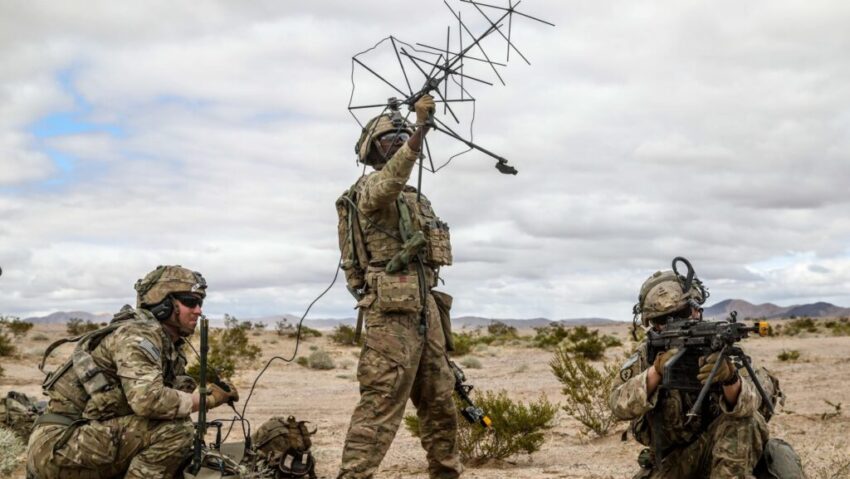US Army Soldiers assigned to 1st Stryker Brigade Combat Team, 2nd Infantry Division use satellite communication systems during Decisive Action Rotation 20-05 at the National Training Center. (Army photo by Pfc. Rosio Najera, Operations Group, National Training Center)
WASHINGTON —Even as the debate over spectrum sharing between the commercial industry and the Defense Department appears temporarily settled, the Defense Advanced Research Project Agency plans to transition one of its spectrum sharing projects out of the lab and into the field by next year.
Members of the team on the COmpact Front-end Filters at the ElEment-level program, called COFFEE for short, developed “ultra-compact” radio frequency filters that integrate into advanced antenna arrays on different systems. The goal is to isolate or suppress specific signals, which could allow DoD and commercial tech to safely share the congested 2-18 GHz portion of the spectrum without interference, Todd Bauer, program manager of COFFEE, told Breaking Defense in an interview Thursday.
“I would say that our technology is not a solution to all problems,” Bauer said. “It has limits in terms of the power handling that it can do, but for us, for a relatively broad spectrum of systems, it means that we have better isolation between adjacent frequency bands of interest.
“And what that means is that we can do more with it. We can have communication channels that are adjacent to one another without any kind of bleed of spectrum from one channel into another. At its core, that’s really what we’re going for here — we want cleaner use of available spectrum.”
Bauer said the COFFEE program, which began lab testing in 2022, plans to deploy its filters for three different designs by “mid to late 2026.” One will be focused on DoD advanced radars, another on DoD Common Data Link radios and the last on commercial-based 6G installations. If all goes well, the three systems will be able to take turns operating on the same bands without the fear of one or more systems facing interference and jamming.
This in turn has the potential to alleviate some of the concerns lawmakers, defense officials and members of the Federal Communications Commission have long faced regarding battling over who gets certain access to portions of the spectrum — particularly the 3.1-3.45 GHz and 7.4-8.4 GHz range, which DoD says it needs for various satellite communications, radars and navigation systems but the commercial sector covets for civilian use.
“In a perfect world, we’re on the path to offering at least a partial solution to that problem,” Bauer said.
Related: Not on the same wavelength: Trump inherits spectrum fight between DoD, commercial industry
Lawmakers recently mandated in the reconciliation bill that the 3.1-3.45 GHz and 7.4-8.4 GHz portions of the spectrum will not be auctioned off and will remain in the DoD’s control. In an exclusive op-ed for Breaking Defense, Sens. Deb Fischer, R-Neb., and Mike Rounds, R-SD., wrote that the language also prevents requirements to share that spectrum.
“The issue is settled for the next decade. Down the road, we will revisit these issues,” the two Senators wrote. “And when that time comes, while we recognize that technology will evolve and our security challenges will change, one thing must remain constant: national security is not negotiable.”
When asked how the recent reconciliation decision impacts the COFFEE program, Bauer said, “really, it doesn’t.”
“We’re working on technology solutions to technology problems. We’re tracking policy. We’re responsive to policy, but it’s not sharply influencing the work that we’re doing here,” he said. “I think to me, what it means is that, for now, commercial use of that spectrum is delayed, and perhaps that that will be enduring. I think it’s up to the policymakers to establish that.”
Though recent events have drawn attention to solely the 3.1-3.45 GHz and 7.4-8.4 GHz bands, Bauer said his team remains focused on a wider range to prevent such spectrum battles from arising later on.
“DARPA is a forward looking organization. Nobody ever wants less bandwidth or less spectrum,” he said. “So it totally makes sense that we would explore, you know, from 2-18 gigahertz, which is larger than what is in focus now for Congress and the DOD and the FCC. But we’re happy to be prepared for [how] to provide a technology solution at those higher frequencies once both the commercial space and the DoD space are working there.”
Click this link for the original source of this article.
Author: Carley Welch
This content is courtesy of, and owned and copyrighted by, https://breakingdefense.com and its author. This content is made available by use of the public RSS feed offered by the host site and is used for educational purposes only. If you are the author or represent the host site and would like this content removed now and in the future, please contact USSANews.com using the email address in the Contact page found in the website menu.








